Selecting the right cut (1.5-2" thick, good marbling) from a reputable butcher is key for a tender, juicy BBQ Beef Brisket. Seasoning with salt, pepper, paprika, garlic powder, cayenne, and mustard seeds enhances flavor. Slow cooking at 225°F-250°F (107°C-121°C) for 1-1.5 hours per pound (up to 12 hours for a 10-pound brisket) breaks down proteins for maximum tenderness. Dry aging (1-3 weeks at 35-40°F/1.7-4.4°C, 60% humidity) enhances flavor and texture. Choose high-quality sauces sparingly towards the end to preserve juices. Rest, slice against the grain, and serve with garnishes for an impressive presentation. Master consistent temp control, rest time, and internal temps (195°F-205°F/91°C-96°C) for a perfect BBQ Beef Brisket Recipe.
Unleash your inner BBQ master with our comprehensive guide to cooking the perfect brisket. From selecting top-quality meat to crafting a killer rub and mastering the art of dry aging, we’ll equip you with the knowledge for amazing results. Learn the science behind smoking and discover the secrets to slicing and serving a mouthwatering BBQ beef brisket recipe that will have your friends and family begging for more.
- Choosing the Right Brisket: Tips for Quality Meat
- Seasoning 101: Crafting a Killer Rub
- The Science of Smoking: Optimal Temperatures and Times
- Master the Art of Dry Aging for Enhanced Flavor
- Sauces and Glazes: Adding the Final Touch
- Slicing and Serving: Presenting Your Perfect Brisket
- Troubleshooting Common BBQ Beef Brisket Issues
Choosing the Right Brisket: Tips for Quality Meat
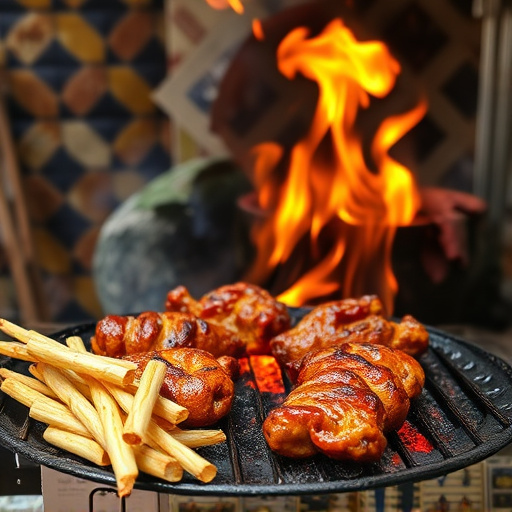
When it comes to achieving amazing results in your BBQ beef brisket recipe, selecting the right cut is paramount. Opt for a high-quality brisket with good marbling—the fat streaks within the muscle. Look for a piece that’s between 1.5 to 2 inches thick, ensuring even cooking and tender meat. Avoid briskets with excessive fat or those that feel too lean, as these can result in dry, tough meat. The ideal cut should have a balanced blend of muscle tissue and fat, which will render during the slow-cooking process, adding flavor and keeping the brisket moist.
Consider sourcing your brisket from a reputable butcher who can guide you in choosing the best cut for your cooking style. Freshness is key; choose a brisket that was recently processed, ensuring optimal taste and texture. Remember, the better the quality of your starting meat, the more impressive your final BBQ beef brisket recipe will be.
Seasoning 101: Crafting a Killer Rub
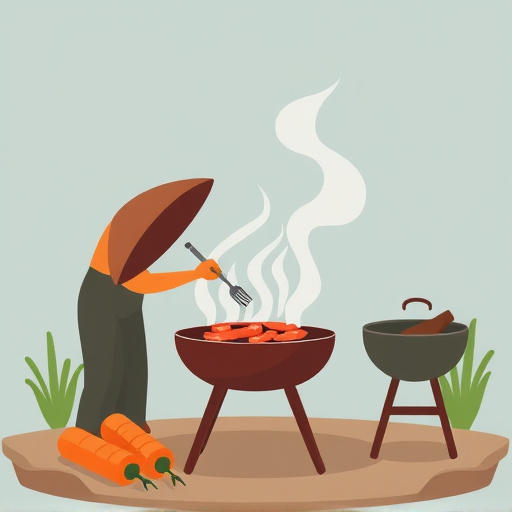
When it comes to brining your BBQ beef brisket recipe to life, seasoning is key. The art of crafting a killer rub is an essential step in achieving mouthwatering, tender brisket. Start by combining coarse salt and pepper as a foundation, allowing these classic flavors to dominate. Next, add a mix of spices like paprika, garlic powder, onion powder, cayenne (for heat), and mustard seeds for depth and complexity. Adjust the ratios based on your preference—a generous rub will infuse more flavor, while a lighter coating allows the natural brisket juices to shine.
Experiment with other aromatic herbs and spices such as dried chili peppers, cumin, or even a pinch of nutmeg for unique twists. Remember, a well-seasoned brisket is a delicious one, so feel free to get creative! Ensure your rub sticks to the meat by using a dry brushing technique during the cooking process—this will help lock in the flavors and create a stunning crust.
The Science of Smoking: Optimal Temperatures and Times
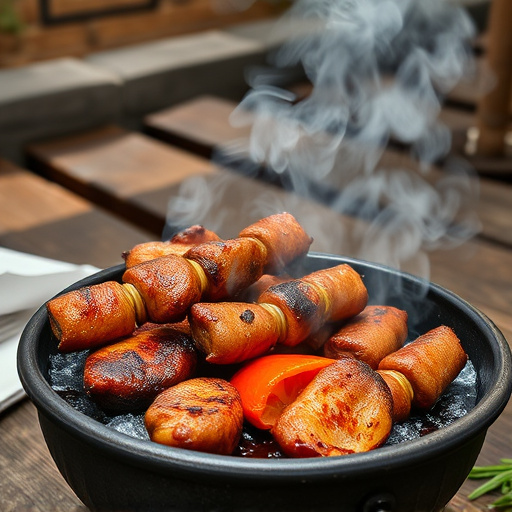
The art of smoking BBQ beef brisket is a precise science that involves understanding temperature control and patience. For optimal results, aim for low and slow cooking methods. The ideal smoking range for brisket is between 225°F to 250°F (107°C – 121°C). This gentle cooking temperature allows the meat to break down slowly, ensuring a tender and juicy finish.
Timing is equally crucial. Brisket takes time to reach its peak flavor, with the recommended cooking duration being approximately 1 to 1.5 hours per pound at these lower temperatures. So, for a standard 10-pound brisket, plan for an 8 to 12-hour cook time. This extended period is what transforms tough muscle fibers into melt-in-your-mouth tenderness, making it the secret ingredient in any successful BBQ beef brisket recipe.
Master the Art of Dry Aging for Enhanced Flavor

To elevate your BBQ Beef Brisket Recipe to new heights, consider the art of dry aging. This process, which involves storing raw brisket at specific temperatures and humidity levels for several weeks, allows the meat to develop a more complex flavor profile. By exposing the brisket to oxygen, enzymes naturally break down proteins, resulting in tender, succulent meat with enhanced savory notes.
Dry aging also encourages the formation of intramuscular fat, which acts as a natural moisture barrier once the brisket is cooked. This ensures your final product stays juicy and flavorful, even after slow-cooking for hours over low heat. For best results, aim for a temperature between 35°F to 40°F (1.7°C to 4.4°C) with relative humidity around 60%. This delicate balance will transform your brisket into a true culinary masterpiece that satisfies even the pickiest of BBQ enthusiasts.
Sauces and Glazes: Adding the Final Touch
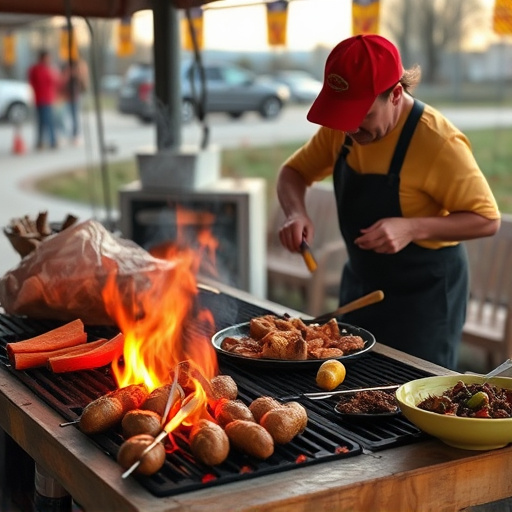
Sauces and glazes are the final touch that can elevate your BBQ beef brisket recipe from good to great. Experiment with different flavors—from a classic barbecue sauce to a sweet and tangy apple cider glaze—to find your favorite. Timing is key; apply sauces sparingly and towards the end of cooking to prevent steaming, which can dilute the flavor. Letting the sauce caramelize on the brisket adds depth and richness. Remember, less is often more; a little bit of sauce goes a long way in enhancing the natural juices and flavors of the beef.
For best results, use high-quality ingredients and adjust recipes to taste. Sauces can be easily made from scratch or purchased pre-made; either way, they should complement—not overpower—the brisket’s natural flavor. Consider brushing on sauces during the last 30 minutes of cooking for a shiny, caramelized finish. This simple step can make all the difference in the final presentation and taste of your BBQ beef brisket recipe.
Slicing and Serving: Presenting Your Perfect Brisket
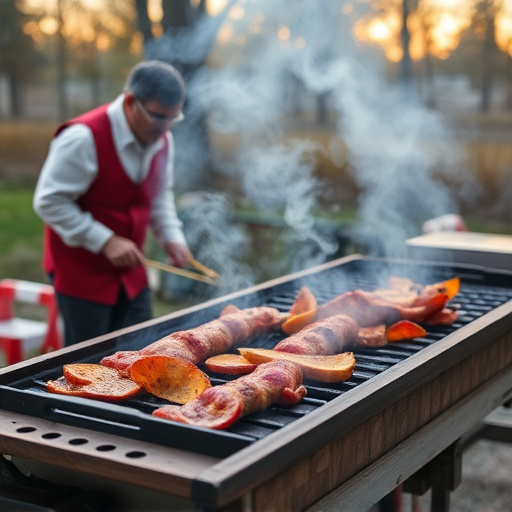
When it comes to slicing and serving your perfectly cooked brisket, presentation is key for an exceptional BBQ beef brisket recipe experience. Start by removing the point (the leaner tip portion) from the flat (the fattier, more tender part). This allows for a better contrast in textures when sliced. Next, let the meat rest at room temperature for about 30 minutes before slicing to ensure even juiciness throughout.
Slice your brisket against the grain, which runs parallel to the long fibers of the meat. This method ensures each slice is tender and easy to chew. For a show-stopping plate, combine thin slices of brisket with your favorite BBQ sauce, and garnishes like pickled onions or jalapeños. Serve it up on a hearty platter, allowing your guests to indulge in this mouthwatering BBQ beef brisket recipe masterpiece.
Troubleshooting Common BBQ Beef Brisket Issues

Many aspiring grillers struggle with achieving perfect results when cooking BBQ Beef Brisket recipes. Common issues like dry, tough meat or uneven doneness can be frustrating. The key to success lies in understanding a few simple principles. Firstly, ensure your brisket is properly seasoned before smoking; a good rub will lock in moisture and enhance flavor. Secondly, maintain a consistent, low-and-slow smoke temperature; this promotes even cooking without overcooking the exterior. Regularly check internal temperatures to gauge doneness—aim for 195°F–205°F (91°C–96°C) for maximum tenderness. Lastly, avoid over-lifting or moving the brisket during cooking, as this can disrupt its even heat distribution.
